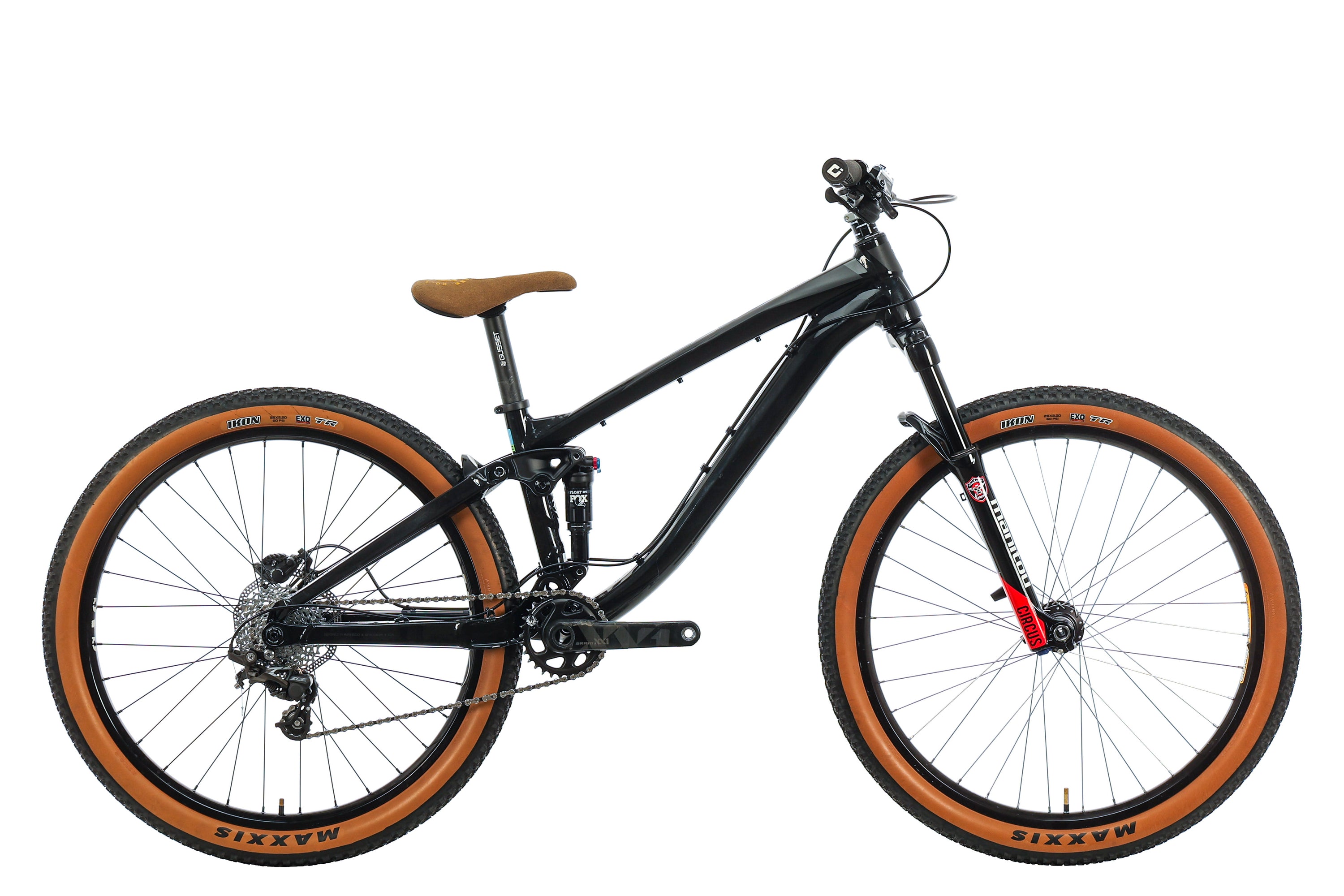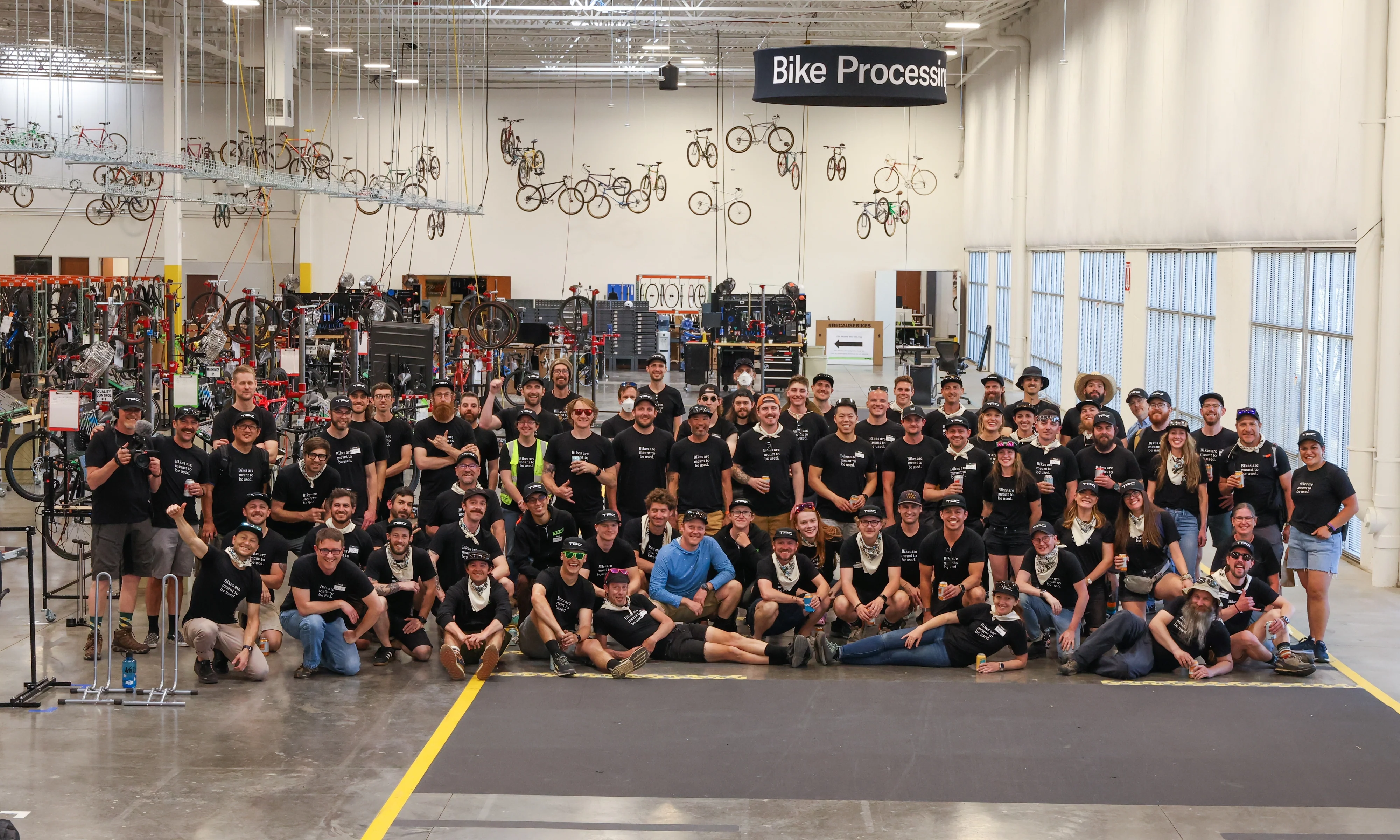This is the Trek Ticket S (“S” stands for slopestyle), a unique full-suspension dirt jump bike (a.k.a. “dirt jumper” or “DJ”) that has been purpose-built to handle the bigger jumps and features often found on slopestyle courses.
TPC typically doesn't buy or sell dirt jumpers, but we made an exception for this 2018 Trek Ticket S. It’s here because it’s fairly rare, it’s super cool and unique, and most importantly, it’s the most iconic dirt jumper/slopestyle bike ever made.
[button]Shop Mountain Bikes[/button]
The Ticket S is Ridden by Legends
 Emil Johansson flipping his Ticket S at Crankworx Innsbruck, 2023. Phot: Bartek Wolinski / Red Bull Content Pool
Emil Johansson flipping his Ticket S at Crankworx Innsbruck, 2023. Phot: Bartek Wolinski / Red Bull Content Pool
Dirt jumping is one of the more niche segments of mountain biking. In fact, I’d say that dedicated dirt jumpers are even less common than dedicated downhill bikes, which are already a pretty niche product.
You will usually only see dirt jumpers being ridden at bike parks that cater to them (Valmont Bike Park in Boulder, CO is a great example). Then, among these niche bikes, full-suspension slopestyle bikes are an even more niche subset.
The first year the Ticket S was offered to consumers in 2014, the initial production run was only 125 frames. Compared to standard hardtail dirt jumper frames, the Ticket S is also significantly more expensive. A new frameset currently retails for $1,899.99, while the standard Ticket DJ hardtail is half that, retailing for $949.99.
If you roll up to a set of dirt jumps on a Ticket S, then you’re guaranteed to attract attention. Not just because it’s unique and expensive. It's also a bike with a reputation.
 No one makes the Ticket S look as stylish as Brandon Semenuk. Photo: Ian Collins / Red Bull Content Pool
No one makes the Ticket S look as stylish as Brandon Semenuk. Photo: Ian Collins / Red Bull Content Pool
Here’s a short list of riders who currently ride or previously rode the Ticket S:
- Brandon Semenuk
- Emil Johansson
- Brett Rheeder
- Cam McCaul
- Ryan Howard
- Drew Bezanson
Those are the main riders I can remember off the top of my head, and I’ve surely forgotten a few (let me know who’s missing!), but if you recognize any of those names, then you already know that theses are the best freeriders and dirt jumpers in the world.
The Ticket S has also scored more professional slopestyle wins than any other bike. Just this year, Emil Johansson broke the record for the most Crankworx World Tour Slopestyle gold medals. The previous record holder, Brandon Semenuk, is considered by many to be the greatest freerider/dirt jumper of all time.
If you’ve ever watched any of Semenuks jaw-dropping edits, or a clip from a major slopestyle competition, then you’ve probably seen a Ticket S in action:
The History of the Ticket S
Slopestyle is essentially a crazier form of dirt jumping. The jumps and features are much bigger, and they’re built into a slope so riders can get the necessary speed to clear them. Slopestyle courses can be ridden on a traditional hardtail dirt jumper, and plenty of pro riders do, but some started experimenting with full-suspension dirt jumpers around 20 years ago.
In 2004, Cam McCaul rode a modified full-suspension Trek Session 77 with reduced travel, and Trek has been producing one-off full-suspension dirt jumpers for its pro athletes ever since. While it added weight and complication, rear suspension also helped riders handle increased air time, harsher landings, and bigger tricks.
 Semenuk's 2011 Ticket S prototype. Photo: Ross Measures/SRAM
Semenuk's 2011 Ticket S prototype. Photo: Ross Measures/SRAM
The first Ticket S prototype appeared in 2011 under McCaul and Brandon Semenuk. A total of 5 prototype frames were originally produced — two were kept in Trek’s Waterloo headquarters, two were given to McCaul and Semenuk, and the final one was given to 3-time four-cross world champion, Anneke Beerten, to uses as a four-cross race bike.
The prototype frames are built using a mix of production and custom parts. The aluminum tubing for the front triangle was taken from the Trek Session and Remedy and combined with a CNC machined rocker link and custom-built chainstays and seatstays. For maximum agility, the chainstays were incredibly short at 400mm. Otherwise, the geometry essentially mirrored the “Long” size Ticket hardtail, so that McCaul and Semenuk could easily switch between the frames depending on their needs.
 Cam McCaul rode the prototype Ticket S to a win at Crankworx Colorado in 2011. Photo: Zach White/BikeRadar
Cam McCaul rode the prototype Ticket S to a win at Crankworx Colorado in 2011. Photo: Zach White/BikeRadar
Production versions of the Ticket S finally arrived in 2014, and it has remained essentially unchanged ever since. For the most part, it’s the exact same bike being ridden by Trek’s pro riders, with the exception of Semenuk’s Ticket S frames, which often have carbon fiber seatstays instead of aluminum for more stiffness on big hits.
The Closer Look at Our 2018 Trek Ticket S
 Of course, the rear suspension is the highlight of this dirt jumper. The Ticket S uses Trek’s ABP (Active Braking Pivot) design, which provides 100mm of travel. To pop off massive jumps and handle the incredible compressions generated when landing, the suspension is also extremely progressive.
Of course, the rear suspension is the highlight of this dirt jumper. The Ticket S uses Trek’s ABP (Active Braking Pivot) design, which provides 100mm of travel. To pop off massive jumps and handle the incredible compressions generated when landing, the suspension is also extremely progressive.
 It drives a Fox FLOAT DPS air shock. The Ticket S also has a Mino Link flip-chip in the rocker allows for a 0.5-degree change in head tube angle and a 10mm change in bottom bracket height. The steeper setting is generally used by Trek’s slopestyle competitors. while the low setting can transform the Ticket S into a dual-slalom and four-cross racing machine.
It drives a Fox FLOAT DPS air shock. The Ticket S also has a Mino Link flip-chip in the rocker allows for a 0.5-degree change in head tube angle and a 10mm change in bottom bracket height. The steeper setting is generally used by Trek’s slopestyle competitors. while the low setting can transform the Ticket S into a dual-slalom and four-cross racing machine.
 Up front, the frame can handle 100-130mm suspension forks, and ours 2018 example has a 130mm Manitou Circus. With its beefy 20mm axle and reversed arch, the Circus is a dirt jumping icon in its own right, and it’s actually the fork I use on my own dirt jumper.
Up front, the frame can handle 100-130mm suspension forks, and ours 2018 example has a 130mm Manitou Circus. With its beefy 20mm axle and reversed arch, the Circus is a dirt jumping icon in its own right, and it’s actually the fork I use on my own dirt jumper.
Of course, it’s rolling on 26” wheels. Dirt jumping is one of the rare corners of mountain biking where the small wheelsize still dominates. The Halo SAS aluminum rims are wrapped in Maxxis Ikons, the same tires Brandon Semenuk generally uses on his Ticket S.
 Then there’s the drivetrain. Most dirt jumpers are singlespeeds. With a simple singlespeed drivetrain, there’s less to break when you inevitably crash, and well-built dirt jumps don’t require much pedaling anyway.
Then there’s the drivetrain. Most dirt jumpers are singlespeeds. With a simple singlespeed drivetrain, there’s less to break when you inevitably crash, and well-built dirt jumps don’t require much pedaling anyway.
But the Ticket S is made to be run with a drivetrain. Most commonly, riders will build them up with tougher downhill-specific drivetrains like the Shimano Zee group used here. Having a few gears can help dial in your speed in the run-up to big jumps and features, and if needed, maybe pedal back up the hill.
 On our bike, the shifter is mounted to the handlebars in the standard location. But many riders actually will run the shifter mounted on the downtube instead of the handlebars. Why? Barspins.
On our bike, the shifter is mounted to the handlebars in the standard location. But many riders actually will run the shifter mounted on the downtube instead of the handlebars. Why? Barspins.
Barspins are a core trick in dirt jumping and slopestyle, and a shifter cable attached to the bars will only get in the way. Our Ticket S here clearly isn’t built for barspins. Generally, riders will leave the rear brake hose extra long so it can wrap around the steerer, or they’ll use a more complicated gyro system.
So Who’s the Ticket S For?
 [product-block handle="7513293324480-trek-ticket-s-dirt-jump-bike-2018-large"/]
[product-block handle="7513293324480-trek-ticket-s-dirt-jump-bike-2018-large"/]
The market for a bike like this is admittedly incredibly small. I’m don't hit the bike park much these days, and I'm not going anywhere near big near enough to push the rear suspension of the Ticket S to its limits. So I’m not going to buy it. But do I want to? Heck yes I do! Even if I can't do 360s or back flips (tables and toboggans are my go-to), it’s still an incredibly unique and cool toy, and that’s reason enough for me to want one.
This Ticket S sat by our Production Manager’s desk for a week (he was thinking hard about buying it!) while it waited to get refurbished for sale. Pretty much anyone who walked by would stop and take a look, and 9 times out of 10, they’d say some variation of: “Hey! That’s Brandon Semenuk’s bike.” Few bikes are so iconic that they’re forever associated with a single rider.
I hope this bike finds a good home with plenty of dirt jumps nearby. And I hope the next owner boosts it to the moon, because that’s what it’s made to do.
[button]Shop Mountain Bikes[/button]

























